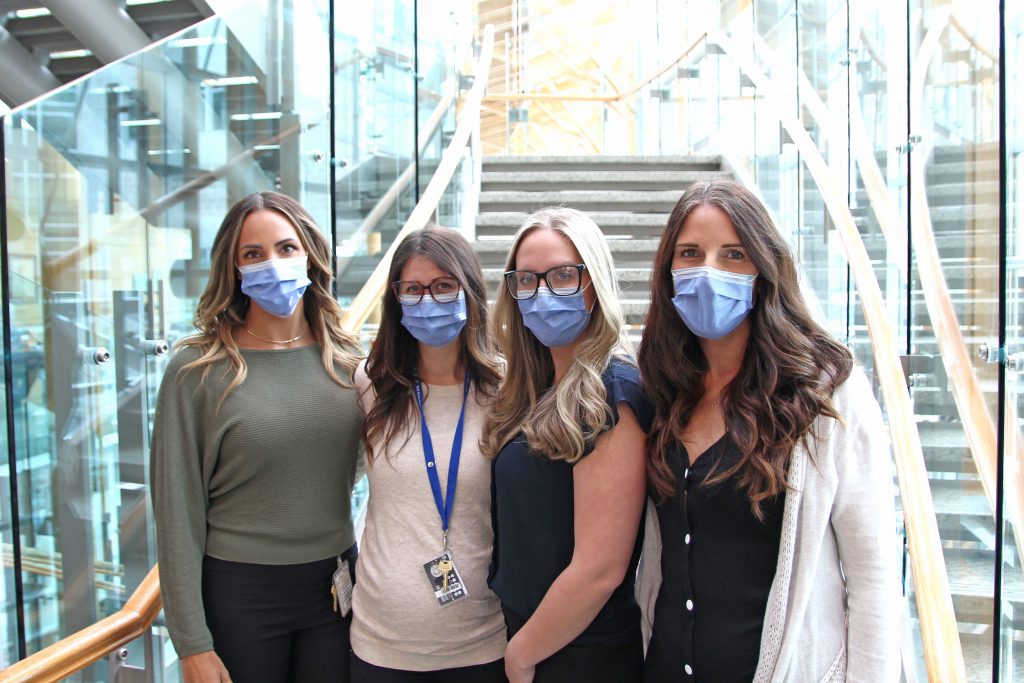Surgical Remote Patient Monitoring – A Game-Changer in Patient Care
by Raiili Pellizzari
 Nurse Practitioners Sashalina DeAgazio, Stephanie Tempelman, Corine Armstrong and Kayley Heppler on the Surgical Remote Patient Monitoring team at TBRHSC.
Nurse Practitioners Sashalina DeAgazio, Stephanie Tempelman, Corine Armstrong and Kayley Heppler on the Surgical Remote Patient Monitoring team at TBRHSC.(Originally published in the May 2023 edition of The Walleye Magazine)
The impact the pandemic has had on reshaping health care is undeniable. With expanding the use of digital platforms and health technologies, innovation has improved the health care experience for both patients and providers. One example is the Surgical Remote Patient Monitoring (RPM) team at Thunder Bay Regional Health Sciences Centre (TBRHSC), who is using a web-based platform to offer pre- and post-operative health care to patients from wherever they connect to the internet.
As Caroline Fanti, Director of Regional Surgical Services explains, “We introduced Surgical RPM in November 2020 as a means to enhance TBRHSC’s pandemic response. Our team utilizes a digital tool [SeamlessMD] to engage and monitor surgical patients across Northwestern Ontario.”
Initiating the program during the height of the pandemic was a means to protect patients and manage limited hospital resources, shares Dr. David Puskas, Medical Director of Musculoskeletal Health and Senior Orthopaedic Surgeon at TBRHSC.
“Hospitals are great places when they are necessary, but also, quite frankly, patients can experience a heightened risk of infection while they are admitted. With the challenges of flu seasons, COVID-19 and admission restrictions, Caroline Fanti and I looked for a solution where we can provide the kind of surveillance that patients require, that connection with their care team, and not have patients expose themselves to the risk of hospitalization.”
The digital tool has personalized information for preparing for surgery through recovery with a digital library, daily tracking and remote monitoring. Dr. Puskas says the response from his patients has been overwhelmingly positive.
“Our pilot study showed patient satisfaction was far higher than it was before we started to reduce length of stay,” states Dr. Puskas. “We are using technology in a way that gives patients confidence and control over their own health care. And also facilitates staying out of the hospital, which is good for everybody.”
For Dr. Travis Marion, Orthopaedic Surgeon and Medical Lead for Spinal Surgery, surgical RPM has been a game-changer.
“It has empowered my patients by providing them with a significant amount of knowledge at their fingertips, daily questionnaires, exercises and information patients may want to have perioperatively,” says Dr. Marion. “They come in better informed and prepared for their procedure and the course of their care.”
The key to the success of Surgical RPM is that it is a shared model of care. The team has a continuum of providers including the clerical staff who aid with the institution of SeamlessMD, the nurse practitioners (NPs) who answer daily queries and the surgeon, who is available as required.
Nurse practitioners Kayley Heppler and Stephanie Tempelman explain they act as a patient advocate and liaison for thirty days post-op.
“As NPs, we are able operate autonomously in our role,” remarks Heppler. “We perform comprehensive assessments, diagnose, order and interpret diagnostics, prescribe pharmacological and therapeutic interventions and refer to interdisciplinary team members. We rule out complications and work closely with surgeons to meet patient needs.”
“We use SeamlessMD on a daily basis to support patients with internet access in Thunder Bay and across Northwestern Ontario” adds Tempelman. “We monitor concerns that are reported by the patient and it helps us to connect with them to support them. For example, with wound care, if patients are concerned about bruising, redness or swelling, they can submit photos for us to review. The ability to video chat and connect with people in their homes is a huge asset of this program.”
The Surgical RPM team at TBRHSC now supports certain orthopedic, bariatric, gynecological, urological, spine, colorectal and breast surgeries while using technology to narrow the distance between provider and the patient.
“And the faster we can get patients out of the hospital, the more rapidly they will recover the function and the ability to be in their home environment,” summarizes Dr. Puskas. “Remote patient monitoring is a crucial part of bridging that gap. They have the best of both worlds – they are out of the hospital and they have contact with their surgical team, at all levels of that team.
“It’s the future and it’s a bright one.”